
Man of Hawai‘iExcerpt from Charles Reed Bishop: Man of Hawaiiby Harold Winfield Kent, Kamehameha Schools President 1946-1962 Pacific Books Publishers 1965 From Chapter 6: Fruition: THE CHARLES R. BISHOP TRUST Bishop, upon settling-in at San Francisco in 1894, quickly found it difficult to manage his many interests in Hawaii because of the dissatisfactions arising not only from the lag in correspondence but also from the very nature of the correspondence itself. People were faithfully clamoring that he continue with his many responsibilities, even though he was 2500 miles away, a ten-day ocean trip. The Trustees of the Bernice P. Bishop Estate developed a reluctance to decide certain matters without his expressed opinion as a Trustee. It was, therefore, a practical necessity that he devise some instrument such as a special trust deed, primarily for handling his many bequests, but also for guiding and handling the far flung and rather complicated Hawaii matters which he had left behind and yet which he could not in conscience cast adrift. On August 1, 1895, about a year after his arrival in San Francisco, he prepared such a Trust deed, named I the Charles R. Bishop Trust, and dispatched it to the Trustees of the Bishop Estate in Honolulu. This Trust deed answered his immediate purpose of providing direction for his charities and philanthropies, and ultimately constituted the back-bone of the Bernice Pauahi Bishop Museum financial structure. It emerged as a monument to his conscientious sensitivity to community efforts in Hawaii. The document proposed the utilization of the Trustees of the Bernice P. Bishop Estate. On August 12, 1895, the Trustees of the B. P. Bishop Estate, with Messrs. Hyde, Damon, Cooke, and Carter present in the meeting, accepted the new Trust deed. On September 4, 1895, C. M. Cooke was elected President and Bishop, Vice-President. September 4, 1895, can be accepted as the date of the founding of the Charles R. Bishop Trust. The momentum of the anticipated relief picked up so rapidly that within five years Bishop had almost eliminated himself from the Hawaiian scene, except for the incidental and personal correspondence. He was, however, to remain a voluminous correspondent, and to write letters up to the day of his death. The Trust deed specifically provided for the support of the Bernice Pauahi Bishop Museum and included funds for any new community enterprises which might come within his permissive directive in establishing the Trust. Under the provisions of the Trust, the Trustees decided to assist Kamehameha Schools' students with partial fee scholarships, and students in other schools, particularly those programmed for the education of Hawaiian girls. They assisted certain churches. They lent assistance wherever a need consonant with Bishop's intention might suggest itself. Bishop foresaw clearly the future needs of the Museum sine he not only provided the many discretionary "assists" in all directions but insisted upon the "mandatory" provision for the memorial (Museum) to his wife. The foundation of the Trust was a personal note given by Samuel M. Damon in 1894, in the amount of $800,000, this amount being the sales price of the Bishop Bank. The single capital fund note was replaced on April 4, 1895, with fourteen promissory notes: two for $50,000 each, and four for $25,000 each, each payable June 1, 1990; and four for $100,000 each, and four for $50,000, each payable June 1, 1905. All called for 4 per cent interest. Under the Charles R. Bishop Trust deed on August 1, 1895, these promissory notes aggregating $800,000 were assigned to the Trustees as the corpus of the Trust. Some of the notes were exchanged for Oahu Railway and Land Company bonds at 6 per cent interest. Others were exchanged for 6 per cent Olaa sugar bonds. Some were the source of funds for the payments of major bequests as listed in the Trust deed. Some money went into the repayment of advances made by Bishop in building the Bernice Pauahi Bishop Memorial Chapel. But the bulk remained as the basic capital structure of the Museum. He directed that "The Trustees shall not suffer the Trust Fund to become less that $500,000." He was acutely aware of the Museum's problem. He wrote Hyde on January 22, 1897: You will have to excuse me from adding anything to my contribution to the Historical Society. I have not altogether given up the idea of establishing an Aquarium, though I may come to that conclusion. I now think that all that can be saved and accumulated from the Charles R. Bishop Trust should be saved that it may be used for the Museum in any branch or department that may be connected with it… In 1897, a second annex was approaching the final drawing stage. The outreach of scientific study was calling for more scientists, special cabinets constructed, treatises published; and money was needed faster than he was willing to award it from the proceeds of the notes. There was an overdraft at the bank in January of 1897. These expenses were due chiefly to the enthusiasm of Brigham, who had been talking strongly of an aquarium, a marine laboratory, and other interesting projects; and they caused Bishop to apply the brakes. He requested that virtually all the awards to schools, seminaries, churches, and other beneficiaries be placed upon a "discretionary basis;" that the spending be watched carefully; and that the trustees remain within available income. In a letter to Henry Holmes, he wrote: To pay off the debt of the Museum, and forever after keep out of debt, should, I think be the aim and settled policy of the Trustees. No new thing calling for money should be undertaken without funds in hand or immediately available. Nothing can be done about an aquarium, etc., at present, and if anything is to be done in the future worth undertaking, it is necessary that the fund of the Museum shall be carefully guarded and the income husbanded for that purpose, and a very considerable sum will need to be drawn from the C. R. Bishop Trust. In the management of that Trust, it seems to me that the Museum should be given preference over every other object mentioned in Sub-Division 8th of the Deed. The Trustees have large discretion and can cut off or reduce expenditure for kindergartens and night schools, and playgrounds. With such help from the Trust, added to what I may be able to furnish, it may be possible to add to the Museum such an Aquarium and Laboratory as will attract scientists of high class, and be a credit to all concerned. Of course the Museum proper is first to be made what we wish it to be… In the provisions of the Trust deed originally dated August 1, 1895, but amended on July 24, 1897; December 14, 1897; November 22, 1904; April 8, 1910; June 27, 1914; and October 5, 1914, we see the unfolding and modifying processes of change at work. In the First Section he authorizes the delivery of one promissory note in the amount of $50,000 to Cordelia Church Allen, wife of William F. Allen. After Mrs. Bishop's death, he moved into Keoua Hale, the 21 Emma Street palace which Ruth Keelikolani had willed to Mrs. Bishop in 1883 and which, in turn, Mrs. Bishop had willed to her husband in 1884. Here he set up housekeeping in dignified, hospitable mood and invited the Allens to be his resident hosts. This arrangement lasted until 1894, Bishop's departure year; but the Allens stayed on for some years. It was from this house that the furnishings gathered in the United States and Europe, particularly in France and Italy, were distributed in part to The Kamehameha Schools, the Bishop Museum, Punahou School, and to such relatives as the E. Faxon Bishops and others. It was in gratitude for a life of long friendship with the Allens and their unfailing assistance as his official hosts at the Emma Street home that he made the $50,000 bequest. The Second Section of the Trust deed merely refers to the extension of due dates of the Damon notes, possibility of prepayment by Mr. Damon, and the application of income. In the Third Section, Bishop begins the detailed list of benefactions. There are many: Mills School [Mills Institute] Hilo Boys' Boarding School Young Men's Christian Association of Honolulu Queen's Hospital American Relief Fund Honolulu Library and Reading Room Association Hawaiian Evangelical Association Maternity Home Night Schools in Honolulu The Fourth Section provides: Out of my balance of interest remaining in the hands of my said Trustees, as soon as such balance is ascertained, they shall pay the Hawaiian Historical society the sum of Two Thousand ($2000) Dollars. The Fifth section deals first with the maintenance of the tomb, monument, and grounds of the Royal Mausoleum. Both Mr. and Mrs. Bishop are buried here. The care referred to in the paragraph is mandatory upon the Trustees. "Founder's Day" at The Kamehameha Schools is a second mandatory provision. $200 is set aside for this annual ceremonial. Each December 19, children of The Kamehameha Schools march into the Royal Mausoleum; group themselves in front of the brown granite marker over the Kamehameha crypt; and proceed with a dignified, sincere tribute to their benefactress, Bernice Pauahi Bishop. It was in his mind that the mandatory annual payments of the $200 would serve to preserve the memory of Mrs. Bishop in the minds and hearts of the succession of students passing through the doors of Kamehameha. In a letter to Hyde, December 28, 1896, Bishop expressed a desire to assist Hawaiian girls between the ages of six and fourteen at St. Andrew's Priory and Sacred Hearts Academy in the amounts of $250 for each school under the terms of the Fifth Section. The Trustees started out with $300 in 1897, increasing this to $600 in 1948 for Sacred Hearts Convent with a final payment in 1954, making the total contribution $19,700. The $300 was increased to $1160 for the Priory in 1948, and the payments were concluded also in 1954 with a total of $23,217 having been paid for operating aid. In both schools the monies were in payment of tuition and board for Hawaiian girls who were students. Hyde was a member of the Board of Trustees of the Charles R. Bishop Trust and was able to link the gift with the need. He suggested Makawao Female Seminary on Maui and Kohala Girls' School on the Island of Hawaii. Paragraph Four of the Fifth Section provides half scholarships at the Kamehameha Schools for students whose parents are unable to pay the full fees. Scholarships of this type were awarded annually in totals averaging $500 from 1896 through 1947. The Trust made available about $25,000 in these supplemental allowances. As the Bernice P. Bishop Estate income increased it was no longer necessary to draw such scholarships from the Charles R. Bishop Trust and the requests were cut off. It was within the discretion of the Trustees to do this. Free kindergartens, with special reference to those maintained for Hawaiian children of pure or part aboriginal blood, were granted the sum of $600 annually for the life of the Trust-this also at the discretion of the Trustees. Payments began in 1895 and ended in 1954 with a total of $35,700 having been paid into the Free Kindergarten Association. In the annual "Calendar" of the Association, the grant was called the "Charles R. Bishop Annuity." This substantial support led to an unusual recognition. His name was listed in the first annual report and is stilled carried in the wise: "Hon. C. R. Bishop, Honorary Member." The earliest mention of a kindergarten is in connection with F. W. Damon's Chinese project of September, 1892. Damon was interested in Chinese boys, and opened a kindergarten in the Chinese Mission on Fort Street. Bishop had given money in 1892 to Damon partly on account of the kindergarten in the Mission. In 1893 the Woman's Board of Missions for the Pacific Islands opened four kindergartens specializing in several racial groups: Portuguese, Japanese, Hawaiian, and one for children of all other races. By 1895, the work was exceeding the capacity of the Woman's Board of Missions and the "Free Kindergarten and Children's Aid Association" came into being. This coincided with the creation of the Charles R. Bishop Trust, and the new kindergarten organization was included. Writing to Hyde, November 30, 1895, Bishop said, "…You know that I am interested in the Kindergarten, and you know to what extent I have undertaken to aid it. I would not wish to discontinue aid to the Kindergartens in Honolulu on any account…" Paragraph Six provided $1500 for the salary of a chaplain at The Kamehameha Schools. This provision was not always adhered to nor was it often needed. The graduates of The Kamehameha Schools were few in number in 1895, had no organization, and probably had not thought of an association until the provisions in Paragraph Seven were published. To the Alumni Association of Social Club for those who had attended Kamehameha Schools not less than two years, the sum of $300 was allowed on an annual basis. The payments from 1897 on have been made with fair regularity and total in excess of $25,000. To three churches, Central Union, Kawaiahao, and Kaumakapili, an annual sum of $100 was provided. Bishop's connection with Kaumakapili was rather slight, but it was the "second" native church in Honolulu and would normally come within the purview of his concern. Kawaiahao and Central Union were different. Under the Trust deed, even with a minor provision of $100 annually, the total sums from 1895 to 1954 reached $6,000 for each $18,000 for the three. Paragraph Nine provided payments to the Kona Orphanage of Kailua, North Kona, in unnamed amounts. The school was for a time called the Hawaiian Orphanage and Industrial School and survived only as long as Miss Alice Beard was its manager payments started in 1903 and continued through 1907 for a total of $2250. The other institution mentioned in this section is the Kaiulani Home for Young Women in Honolulu. Annual payments for the Kona Orphanage and the Kaiulani Home were limited to $1000. Beginning in 1903, the Kaiulani payments were $500 but were increased to $1000 in 1907. These payments ended in 1942 when the Home could no longer fulfill its purpose of housing Hawaiian working girls or college students. But even with the termination of payments in 1942, the Kaiulani payments amounted $33,000. Section Six makes two cousins of Bishop his personal beneficiaries. To Charles H. Bishop of Lihue he gave $15,000 and to E. Faxon Bishop of Honolulu, $10,000. Paragrpahs Three and Nine of the Sixth Section include $25,000 for the Honolulu Library and Reading Room Association, $18,000 for Queen's Hospital, $25,000 for the Hilo Boys' Boarding School, $20,000 for the Hawaiian Evangelical Association, $5,000 for the Young Men's Christian Association, $3,000 for the American Relief Fund Association, and $5,000 for the Maternity Home. In Paragraph Ten, the American Board of Commissioners for Foreign Missions at Boston, Massachusetts, were to be paid $3,000 and $5,000 upon transferring title to the collection of antiquities and articles to the Trust created by the Will of Bernice Pauahi Bishop. In Paragraph Eleven The Schools' chapel was subsidized in the amount of $60,000. Oahu College (Punahou School) was to receive $50,000 under Paragraph Twelve. This institution was very dear to Bishop and probably came close upon Kamehameha and the Museum in his interest and affection. There was however an important change in his thinking and could he have arrived at the conclusion expressed in the following passage at the time he was advising his wife about the construction of her Will, there might have been some notable broadening effects of her philanthropy. This was in a letter to Carter, October 3, 1901: Were I to Make the C. R. B Trust over again or amend it I think that instead of providing for any of the Kam graduates to enter Oahu College, I would place the sum provided in the hands of the trustees to be used in assisting such graduates in any school at home or abroad, in their discretion. I take much interest in Oahu College, hoping that those who have enjoyed advantages there and who have abundant means will endow it generously and see to it that it is maintained as a first class school so that it shall be of great value to the present and coming generations; but it may be that in some instances native Hawaiians, assisted, could do better elsewhere. The benefactions now cease except for an open provision in Section Eight where the Trust deed reads: …$100 per annum in the support or partial support of indigent persons, such persons being Hawaiians either of pure or part aboriginal blood… Under the authority granted here the Salvation Army Boys' and Girls' Homes began receiving monies in 1910 up through 1953, and the sum of $28,516 was realized by the Homes during this time. The Honor Loan and Trust Association, especially established to assist needy and deserving students at the Normal School, benefited in 1902 and 1903 with small allowances totaling $500. Bishop was not impressed with this association nor with a companion project for a home for such students on the campus. He wrote to Carter, May 9, 1902: …There are many "worthy objects" that one would like to help if one had the money to spare, so many that one has to pick and choose. The name "Honor Loan & Trust Association" would give the impression that the recipients of loans would expect to repay some time, as should be done. Much as I would like to see more done for Hawaiian girls after they finish school, I know that the B. P. B. Estate cannot contribute at all, and I have come to the conclusion that it would not be prudent to allow a "Home to be located on Estate land near the Kam. Girls Schools or to have it under the care of the principal or teachers of that school. There would be great risk of its falling into financial difficulties and of annoying efforts to get support or aid from the estate. The Trustees have their hands full now, so full that I am anxious. Another interest of the Trust for indigents was the Boys' Brigade. Theodore Richards made a direct appeal to Bishop, and the enterprise was given $1750 over the years from 1901-1904. Still another attempt to assist indigents was the Free Eye and Ear Dispensary which received payments totaling $500 in 1899-1900. While infinitesimal in size and importance, their nature enriches the picture of the Bishop philanthropy. He made one more provision in this Eighth Section, this one personal: …also to pay me during my life such sum or sums of money not exceeding $500 per month, as I may from time to time direct… He never called upon the Trustees for any such payments until but a few months before his death. He wrote to the Trustees of his Charles R. Bishop Trust on September 14, 1914, of his concern that he be personally self-sufficient: In 1913 I made distribution of a large portion of my property to my heirs and friends and objects in which I was interested. Sine that time there have been many important changes in values of bonds, stocks, and other properties, causing a large falling off in income from securities, including those retained by me. There is at present no prospect of improvement in their values, showing that I parted with a larger amount than I could afford at the time. I have no extravagant habits to be corrected by closer economy, but it is quite possible that with increasing age my necessary expenses may be enlarged. Under the circumstances I feel that I have good reason for taking advantage of my right reserved in the deed of trust so that my income may be supplemented during the remainder of my life and save me from granting the right to draw from the income of said Trust at the rate of $5000.00 per annum, in monthly or quarterly payments, as I may request. I may not need to ask for so much every month or quarter, but omitting to do so should not change my right to demand it. It is my purpose to pay all my debts out of my own property and I hope that I may be able to return to the Trust a considerable part, if not the whole sum or sums, that I may receive from it. He followed this with a cablegram on September 21, asking that the annual payment to him be set at $6000 instead of $5000; and on October 6 he requested an actual advance on this account of $1500 to be paid on January 5 and then followed this up with a request for $500 monthly thereafter. These payments were made to the month of his death, June 1915. So faithful to the letter-writing habit was he that he wrote on May 11, 1915, an acknowledgment of the Bishop and Company's draft for $500 received but the day before. He died four weeks later. The other provisions of the Trust deed are administrative in detail. Bishop lived long enough to visualize the solid impact of his Trust upon the life and direction of the charities and educational and religious organizations of the Islands. He was slowly able to direct an increasing proportion of the Trust's income to the growing Museum; "slowly," because each of the other community beneficiaries had an entrenched interest in its own share of the income and had based its program upon that income as definite and undoubtedly perpetual, even though the Trust deed earmarked such payments as "discretionary." By 1954, however, all such payments had at least temporarily ceased; and the Museum operation had benefited accordingly. Through the lengthening days of the Trust, the Museum had more and more come into its own financially. Little money found its way into the Museum treasury the first eight or nine years, and even when the flow started in 1904 it only amounted to $2500. But as the years elapsed, greater amounts were paid to its account. The monies were used for salaries, insurance, special project grants, and publications. Over the half century of annual payments made from income, starting in 1904, the books show a total well above $950,000. Since the Trust is a permanent legal structure, the future would seem to be bright as far as income is concerned. In the creation of this little-known Charles R. Bishop Trust, Bishop most thoughtfully and carefully eased his concern for the best possible continuation and extension of the community interests which he had singly or together with Mrs. Bishop had nurtured, and in some way provided for while living in Hawaii. He was a benefactor's benefactor. |
Man of Hawai‘i
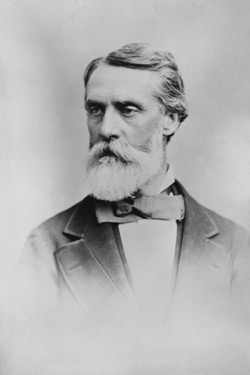
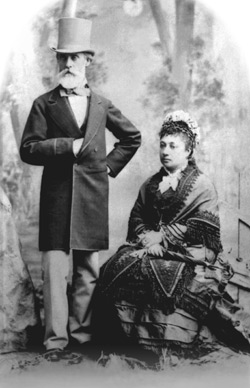
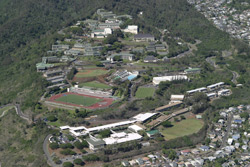
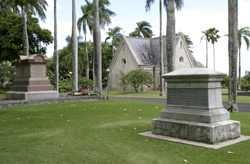
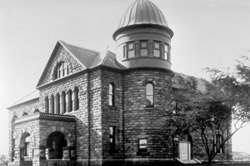
|